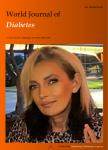Type 1 diabetes and polyglandular autoimmune syndrome: A review
Type 1 diabetes and polyglandular autoimmune syndrome: A review作者机构:Department of Medicine I Johannes Gutenberg University Medical Center
出 版 物:《World Journal of Diabetes》 (世界糖尿病杂志(英文版)(电子版))
年 卷 期:2015年第6卷第1期
页 面:67-79页
学科分类:1002[医学-临床医学] 100201[医学-内科学(含:心血管病、血液病、呼吸系病、消化系病、内分泌与代谢病、肾病、风湿病、传染病)] 10[医学]
主 题:Autoimmune thyroid disease Polyglandularautoimmune syndrome Addison's disease Susceptibilitygenes Type 1 diabetes
摘 要:Type 1 diabetes(T1D) is an autoimmune disorder caused by inflammatory destruction of the pancreatic tissue. The etiopathogenesis and characteristics of the pathologic process of pancreatic destruction are well described. In addition, the putative susceptibility genes for T1 D as a monoglandular disease and the relation to polyglandular autoimmune syndrome(PAS) have also been wellexplored. The incidence of T1 D has steadily increased in most parts of the world, especially in industrialized nations. T1 D is frequently associated with autoimmune endocrine and non-endocrine diseases and patients with T1 D are at a higher risk for developing several glandular autoimmune diseases. Familial clustering is observed, which suggests that there is a genetic predisposition. Various hypotheses pertaining to viral- and bacterialinduced pancreatic autoimmunity have been proposed, however a definitive delineation of the autoimmune pathomechanism is still lacking. In patients with PAS, pancreatic and endocrine autoantigens either colocalize on one antigen-presenting cell or are expressed on two/various target cells sharing a common amino acid, which facilitates binding to and activation of T cells. The most prevalent PAS phenotype is the adult type 3 variant or PAS type Ⅲ, which encompasses T1 D and autoimmune thyroid disease. This review discusses the findings of recent studies showing noticeable differences in the genetic background and clinical phenotype of T1 D either as an isolated autoimmune endocrinopathy or within the scope of polyglandular autoimmune syndrome.



